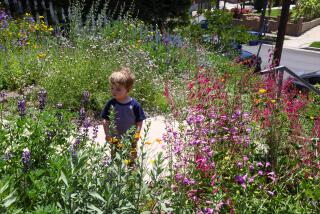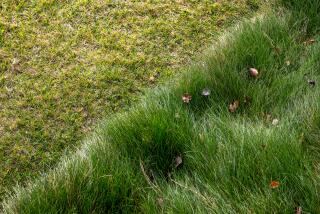GARDENING : Weeding Out a Garden’s Perennial Enemies
Just about everyone had to do it as a kid, and just about everyone loathed it. There were a million better things to do on a Saturday afternoon than kneel in the hot sun and weed, but our unsympathetic parents made us do it anyway.
*
Now, as a parent, I finally understand. I’m counting the months until my 1 1/2-year-old daughter can kneel beside me and continue the tradition.
Weeds are probably the most irksome of all garden pests in their messy conquest of the garden.
Few people would argue that dealing with and preventing weeds is one of the most time-consuming and demanding parts of gardening. Weeds pop up overnight uninvited in even the smallest of crevices and can overrun your garden while you’re on vacation.
This is a banner year for weeds, thanks to the winter’s rains, said Kent Gordon, coordinator of Fullerton College’s horticulture department.
“The rains washed salt out of the soil and provided weeds with a lot of moisture; they’re in heaven with these conditions,” he said.
In addition to the fact that weeds can be unsightly when they overtake a yard, they are also harmful to plants you actually want to surround your home.
Weeds hog food, nutrients, space and light and can be hosts to insects and diseases such as aphids, mealybugs, whiteflies, caterpillars and powdery mildew and rust.
“Weeds have hundreds of thousands of years of natural selection behind them, which means that only the fastest and strongest have survived,” Gordon said. “The plants you bring home from the nursery and baby along are a poor match for weeds.”
There are many common annual and perennial weeds that spring up regularly in Orange County yards.
The worst tend to be perennials, because they have a vast underground food supply, making them very difficult to get rid of, Gordon said. Pull these plants up above ground, and they’ll grow right back.
To make matters worse, many perennial plants--unlike annuals, which generally only grow from seed--also reproduce through rhizomes (these are stems that grow horizontally underground, causing new plants to pop up in other areas of the yard) and stolons (stems that creep along the surface, rooting every few inches and forming new plants).
Some weeds can even root from just a small fragment of a plant, said South Laguna landscape architect Ann Christoph.
One common and particularly troublesome perennial weed that reproduces from rhizomes, stolons and plant fragments is Bermuda grass. This long, stringy green grass is very difficult to destroy, Christoph said.
Another hard-to-eradicate perennial is nutsedge, which Gorden said has nutlets 12 to 18 inches under the soil that send up new shoots when you pull out the plant above ground. This plant has narrow, shiny, apple-green leaves with a strong mid-vein. It tends to favor wet areas.
*
Other potential perennial pests include yellow oxalis, which has foliage that looks like clover and yellow flowers. The ground morning glory can also be a problem, Christoph said.
“This has a fuzzy leaf and beautiful blue blooming flowers, but it is very aggressive and fast-growing and will totally cover a tree,” she said.
One plant that some think of as an ornamental and others as a weed is pampas grass. Once it gets out of control, it requires hard work and strong backs to fight.
“Pampas is a huge grass which has sharp leaves and a feathery flower stock,” said Laguna Beach landscape architect Jana Ruzicka. Once established, this plant can reach 20 feet high and can be almost impossible to remove from a yard.
Another perennial that can be annoying and painful is the stinging nettle. It has bristly, stinging hairs that contain formic acid, which gives a human the sensation of being stung by ants.
In annual weeds, there is bluegrass, which has small blue-green leaves and lays flat to the ground, Gordon said. Other annuals include crab grass; dandelions; tumbleweed; purslane, which has fleshy stems and tiny yellow flowers; chickweed, a plant with long, threadlike stems, and cheese weed, which has foliage that resembles geraniums, tiny hibiscus flowers and green fruit that looks like cheese.
Because there are many weeds that could cause a lot of trouble, it’s worthwhile trying to prevent them from entering your yard. And if they do get in, it’s a good idea to eradicate them as quickly as possible.
“Careful watering will help keep weeds under control,” Gordon said. Drip irrigation will put water right at the roots of favored plants without watering other areas where weeds can establish themselves.
You can also control weeds and conserve water by mulching. A good layer of mulch deprives weed seeds of light, so they don’t germinate. For mulch, use redwood compost, gravel, rocks and even weeds themselves.
“When the weeds are very young and haven’t seeded, you can pull them up and leave them as mulch,” Ruzicka said.
Another good method of preventing the spread of weeds is to plant an aggressive ground cover that will choke out any undesirable plants, Christoph said. Some ground covers that she suggests include vinca major, campanula, various ice plants and any other plant that will fill in an area and prevent weeds from growing.
*
Ground covers are, of course, only useful when you aren’t planting annuals. In gardens and other areas that are constantly changing, you will always have to fight weeds because you are regularly disturbing the soil. Controlling weeds in such areas takes good, old-fashioned weeding, which should be done on a regular basis.
“Spend a few minutes weeding an area when the plants are just an inch high, and you’ll save yourself hours of work later on,” Gordon said. He suggested developing a weeding schedule and sticking to it.
When possible, pull weeds before they have gone to seed, but if you do have to do so afterward, be careful. Don’t spread the seed by shaking the plants around or laying them in a heap, Ruzicka said. “Put them in a plastic bag immediately and dispose of them.”
“While prevention is the best way to go, at times you may need to use chemicals to remove especially stubborn weeds like Bermuda grass,” Gordon said.
There are a variety of herbicides to kill weeds. One is a pre-emergence herbicide, which can be used to kill germinating weed seeds.
For short-lived annuals, Gordon suggests a contact herbicide, which will just kill the plant tissue it touches.
More stubborn perennials need a translocated herbicide, which moves throughout a plant’s system, including into the rhizomes and stolons, and disrupts protein synthesis, causing the entire plant to starve to death. There are non-selective translocated herbicides that will kill anything and selective ones that will kill either all broad-leafed plants in grass or all grass among broad-leafed plants.
Although herbicides don’t leave any residual effects in the soil, Gordon and other experts recommend using these chemicals with extreme caution.
“Herbicides can kill desirable plants and harm people and animals,” he said. “Always follow label directions, and never spray on a windy day.”






